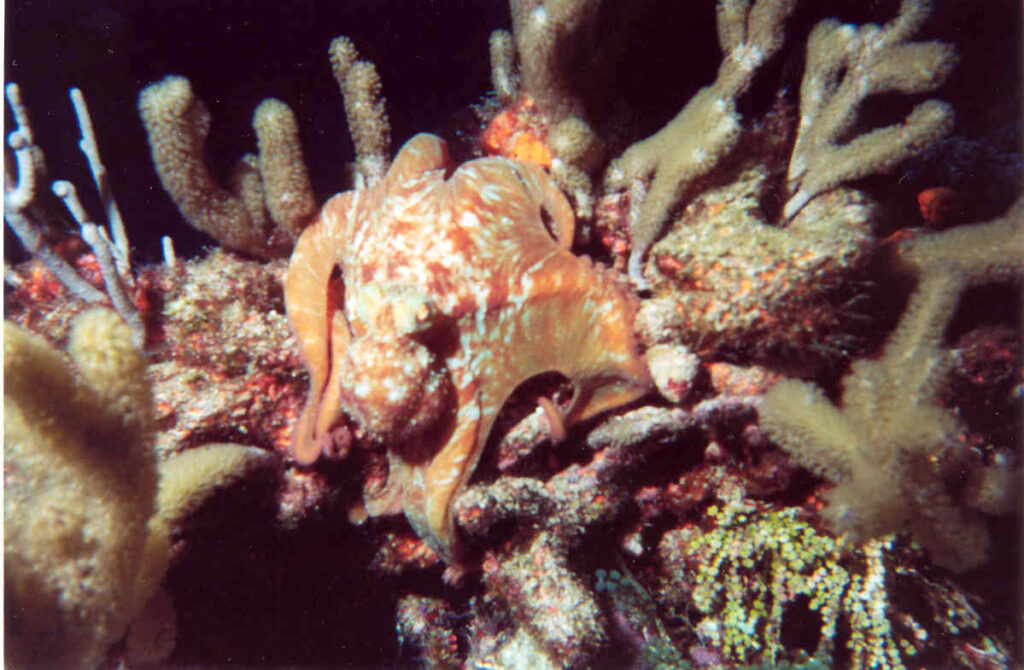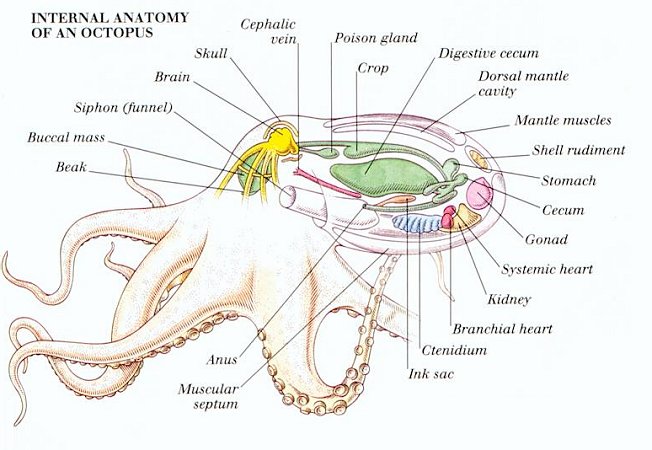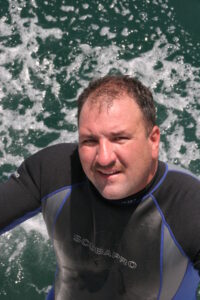Octopuses…or is it Octopi? – Part 1
You have likely heard octopuses or octopi used when referring to the plural form of octopus. You may have even had an argument on the subject of which is correct. So, which one is actually correct? Before we settle that question, let’s learn little bit about one of the most interesting and fascinating creatures that you will encounter on your dive. While we take a stroll through the octopus’s garden (cue The Beatles), you can ponder whether it is octopuses or octopi.
In Cozumel, you are most likely to encounter the Caribbean Reef Octopus (Octopus briareus) or The Common Octopus (Octopus vulgaris). The Caribbean Reef Octopus is a medium size octopus, generally 1-2 feet long and with an average weight of about 3 pounds. With your dive light, its blue-green and brown color makes them quite easy to spot moving across the reef on night dives. The Common Octopus is also a medium size octopus, generally slightly over 3 feet and with an average weight of 12-15 pounds. The Common Octopus prefers sea grass, sand and rubble over coral reefs. They will often make homes of discarded conch shells, empty cans, glass jars and bottles. Both are very similar and share common characteristics with other species of octopus. Both species of octopus are solitary and primarily nocturnal creatures. They tend to remain in the same den for the majority of their lives and will usually only venture out to feed and mate. If they do changes dens, it is likely when they have been disturbed by an intruder.
General Information
There are approximately 300 different species of octopus, which inhabit the shallow reefs to the deepest depths of all of the world’s oceans. The octopus is a soft-bodied, eight–limbed invertebrate in the phylum Mollusca. Mollusca is the second largest phylum of invertebrate animals after the Arthropoda (think insects and crustaceans). The octopus falls into to the mollusk class Cephalopoda, which is Greek for “head-feet”. This includes octopus, squid, cuttlefish and nautilus. They are all characterized by bilateral symmetry, two eyes, a beak and a mouth at the center of its eight limbs. The word octopus comes from the Greek word októpous, which means “eight foot”.

Even though the octopus has a small brain, the octopus is considered to be the most intelligent of all invertebrates. Some would argue that they are among the most intelligent of all animals. Some experiments have shown that an octopus can solve puzzles and identify shapes and patterns while demonstrating both short-term and long-term memory. Studies have shown that an octopus learns easily, including learning from observing another octopus. They have shown the ability to unscrew a jar cap to get the food from inside, including childproof caps.
The octopus is a solitary creature. They typically live alone in coral crevices, dens made of rock and even empty shells. Some will even pull a rock or shell over their den opening, as a door, to protect themselves from predators. Often, some species of octopus conceal the opening to their den by piling up rocks, broken shells, broken glass, bottle caps and other objects. That pile is called an octopus midden or garden. Ringo Starr used this information as the inspiration for the Beatles song Octopus’s Garden. As the story goes, Ringo took a break from the Beatles, while they were working on the White Album in 1968. He took his family to Sardinia, where they were granted the use of Peter Sellers’ yacht. They were served octopus and chips. This led to a conversation with the boat captain, who shared information about the octopus collecting shiny objects and other items to put in front of their den to build a garden. Ringo said that he thought “How great is that!” and he thought about how peaceful it would be to live under the sea; contrary to the current conflict within the Beatles. He then began composing Octopus’s Garden which was included on 1969’s Abbey Road album.
Octopus Anatomy
The octopus has a head, called a mantle, with eight appendages. The muscular mantle houses and protects all of the vital organs. The mantle also aids with contraction and respiration. The octopus has a tubular opening called a funnel or siphon, which serves as a pathway for water. An octopus’ eyes are well developed and provide very good eyesight. Often their appendages are referred to as tentacles, but that is technically incorrect. They are actually called arms.
What’s the difference, you ask. Tentacles are significantly longer and have suction cups only on the tips (think giant squid in 20,000 Leagues Under the Sea). The male octopus has a specially modified arm called a hectocotylus, which contains sperm for reproduction. Two-thirds of the octopus’ neurons are in its arms as opposed to its head. This allows the arms to operate independently and as a result, the octopus can perform several tasks at the same time. An octopus can “walk” with 4 arms while the other arms are probing for food. The average octopus has 240 suckers per arm. The suckers are equipped with chemoreceptors, which helps the octopus to “taste” its food. An octopus has 3 hearts. One heart pumps blood through the organs and the other two pump blood through its gills. The blood pumped by those hearts is blue, because it contains a copper-based protein (hemocyanin) as opposed to the iron-based protein (hemoglobin) which makes human blood red. The only hard structure in the octopus is its parrot like beak, which is used to break open and eat their prey. Given that they have no internal or external skeleton, an octopus can squeeze into any crack, crevice or other hole provided the beak will fit through the opening. All octopus are venomous, which is generally used to subdue prey, although only the blue-ringed octopus, found on Australia’s Great Barrier Reef, is known to be deadly to humans. In fact, the blue-ringed octopus contains enough venom to kill 26 humans within minutes. An octopus living in cold water will typically be much larger than a tropical water octopus.
This concludes part one of our two part article on the Octopus. Oh wait…we didn’t answer the question, “is it Octopuses or is it Octopi?” The second part of the article will be released in two weeks along with the next installment of our newsletter. Tune in then for the conclusion of this article and the answer to this question.




